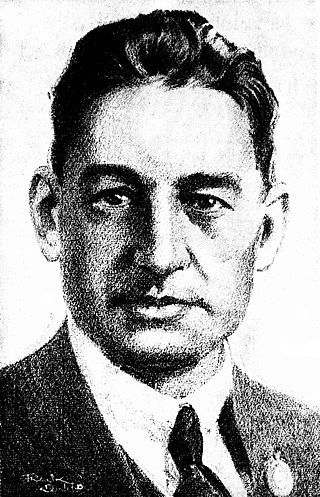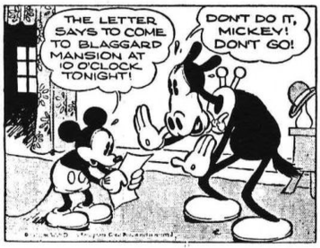Related Research Articles

Arthur Floyd Gottfredson was an American cartoonist best known for his defining work on the Mickey Mouse comic strip, which he worked on from 1930 until his retirement in 1975. His contribution to Mickey Mouse comics is comparable to Carl Barks's on the Donald Duck comics. 17 years after his death, his memory was honored with the Disney Legends award in 2003 and induction into the Comic Book Hall of Fame in 2006.

Theodore H. Osborne was an American writer of comics, radio shows and animated films, remembered for his contributions to the creation and refinement, during the 1930s, of Walt Disney cartoon characters.

Rupert Bear is a British children's comic strip character and franchise created by artist Mary Tourtel and first appearing in the Daily Express newspaper on 8 November 1920. Rupert's initial purpose was to win sales from the rival Daily Mail and Daily Mirror. In 1935, the stories were taken over by Alfred Bestall, who was previously an illustrator for Punch and other glossy magazines. Bestall proved to be successful in the field of children's literature and worked on Rupert stories and artwork into his nineties. More recently, various other artists and writers have continued the series. About 50 million copies have been sold worldwide.

Patrick Peter Sullivan was an Australian-American cartoonist, pioneer animator, and film producer best known for producing the first Felix the Cat silent cartoons.

Mary Tourtel was a British artist and creator of the comic strip Rupert Bear. Her works have sold 50 million copies internationally.

William Henry ('Will') Dyson was an Australian illustrator, artist and political cartoonist who achieved international recognition. He initially worked as a freelance artist in Australia, developing a specialty as a caricaturist, notably in The Bulletin magazine. In 1909 Dyson married Ruby Lindsay and the couple settled in London soon afterwards. As cartoonist for The Daily Herald newspaper, Dyson became widely known as an illustrator and commentator supporting progressive social reforms in Britain. His cartoons were often controversial, tackling difficult issues such as poverty, inequality and war, and were characterised by their biting wit and artistic impact. At the outbreak of World War I Dyson directed his scathing artwork at German militarism. In 1916 he applied to join the Australian forces at the Western Front as an artist. He was appointed an honorary lieutenant and joined the Anzac troops in France in January 1917. By the following May his appointment as Australia's first official war artist was formalised. After the death of his wife in March 1919 Dyson went through a difficult emotional period, during which his artistic output suffered. In late 1924 he returned to Australia after accepting a contract to work for the Herald publishing group in Melbourne. Dyson returned to England in 1930. He died in London in 1938, aged 57.
Fred Basset is a comic strip about a male basset hound. The cartoon was created by Scottish cartoonist Alex Graham and published first in the Daily Mail on 8 July 1963.

Cecilia May Gibbs MBE was an Australian children's author, illustrator, and cartoonist. She is best known for her gumnut babies, and the book Snugglepot and Cuddlepie.
Pip, Squeak and Wilfred was a British strip cartoon published in the Daily Mirror from 1919 to 1956, as well as the Sunday Pictorial in the early years. It was conceived by Bertram Lamb, who took the role of Uncle Dick, signing himself (B.J.L.) in an early book, and was drawn until c. 1939 by Austin Bowen Payne, who always signed as A. B. Payne. It concerned the adventures of an orphaned family of animals. Pip, who assumed the father role, was a dog, whilst the ‘mother’, Squeak, was a penguin. Wilfred was the ‘young son’ and was a rabbit with very long ears.
Japhet and Happy was a British newspaper cartoon strip originally appeared as 'The Adventures of the Noah Family' initially in The Daily News during 1919 and transferred in 1930 to the News Chronicle. It was originated and drawn by J. F. Horrabin, James Francis Horrabin (1884–1962) who was a British journalist, cartoonist and cartographer, and he was elected Labour Member of Parliament for Peterborough from 1929 to 1931. He wrote Political books as well as the 'Dot and Carrie' strip for The Star that ran from 1922 to 1964. The Noah Family names are based on religious names, but the cartoon strips have no religious theme.

Harold Frederick Neville Gye, was a prolific Australian artist, cartoonist and caricaturist under the name Hal Gye and a writer of verse and short stories under James Hackston. Gye's artwork was published in a number of newspapers and magazines including The Bulletin, a journal with which he had a long association both as an artist and a writer. Gye was also a noted book illustrator. His artwork was featured in the books of C. J. Dennis beginning with The Songs of a Sentimental Bloke in 1915 and he also illustrated books of verse by Will H. Ogilvie and Banjo Paterson. As 'James Hackston' Gye wrote verse and autobiographical short stories published in The Bulletin and the Coast to Coast series of anthologies. In 1966 his collected short stories were published as Father Clears Out.
Bobby Bear was a British comics character in the Daily Herald newspaper starting in 1919. He was a young male bear character based on the Steiff teddy bear that was popular at the time. His friends were Ruby Rabbit and Maisie Mouse. Later Percy Porker the pig became a regular character as well as Freddy Fox on occasion. He was the first bear to appear as a cartoon character, pre-dating Rupert Bear by a year.

Cecil Lawrence Hartt was an Australian cartoonist and caricaturist. As a wartime artist, he popularised the concept of the Australian digger as independent, easy-going and disrespectful of authority, with a sardonic attitude to life. He was the first artist to be employed by Smith's Weekly in 1919, continuing in that role until his death in 1930. Over his career Hartt produced a large number of cartoons on a broad range of subjects and themes; his drawings encompassed political, social and military topics and were admired for their observational humour and the quality of his character portraits. He mainly drew single-panel cartoons, but his body of work also includes early examples of Australian comic strips. Hartt was the first president of the Australian Black and White Artists' Club, formed in July 1924.
William St. John Glenn (1904–1974) was an Irish-British illustrator, painter and comics artist.

Sydney Leon Miller was a prolific Australian artist celebrated for his black-and-white work as a cartoonist, illustrator, caricaturist and comic-book author. Known professionally as Syd Miller, he was employed as a staff-artist for Smith's Weekly from late-1922 until 1935, when he left to pursue a diversity of freelance work. Miller created a number of comic-strips during his career, most notably the iconic 'Chesty Bond' character as a marketing campaign for the Australian clothing company Bonds. He also wrote and illustrated the Rod Craig comic-strip which was serialised from 1946 to 1955 and syndicated across Australia and internationally.

Virgil Reilly, was an Australian cartoonist, comic book artist and illustrator. In a long and varied career, he was one of Australia's most famous newspaper and magazine artists and a prolific comic-book illustrator. He was known as 'Virgil', the name he signed on his work. While working for Smith's Weekly during the inter-war years he became well-known for his cartoons of glamorous and seductive young women that became known as 'Virgil's girls'. During World War II he continued to draw cartoons featuring sensual and assertive young women for the Sunday Telegraph and contributed cover art, patriotic cartoons and paintings for the Australian Women's Weekly. In the late-1940s and 1950s Reilly was a prolific and successful comic-book artist, known for his fictional creations such as 'Silver Flash' and the 'Rocket Squadron', as well as his depictions of actual naval battles.

Text comics or a text comic is a form of comics where the stories are told in captions below the images and without the use of speech balloons. It is the oldest form of comics and was especially dominant in European comics from the 19th century until the 1950s, after which it gradually lost popularity in favor of comics with speech balloons.

Mickey Mouse is an American newspaper comic strip by the Walt Disney Company featuring Mickey Mouse and is the first published example of Disney comics. The strip debuted on January 13, 1930, and ran until July 29, 1995. It was syndicated by King Features Syndicate.
References
- Notes
- ↑ "Charles James Folkard".
- ↑ Rickards, Maurice; Twyman, Michael (2000). The encyclopaedia of ephemera: a guide to the fragmentary documents of everyday life for the collector, curator, and historian. Routledge. p. 103.
- ↑ Cadogan, Mary (August 2008). "TEDDY TAIL OF THE DAILY MAIL". Books Monthly. Paul Edmund Norman. Retrieved 2009-11-03.
- ↑ "Charles James Folkard".
- ↑ "Charles James Folkard".
- ↑ "Herbert Sydney Foxwell".
- ↑ "Herbert Sydney Foxwell".
- ↑ "Herbert Sydney Foxwell".
- ↑ "Herbert Sydney Foxwell".
- ↑ "Arthur Potts".
- Sources
- The Adventures of Teddy Tail of the Daily Mail, 1915, A&C Black, London
- Teddy Tail of the Daily Mail: The New Adventures of Mr. Mouse, 1915, newspaper clippings in a homemade book
- Teddy Tail of the Daily Mail: In Nursery Rhyme Land, 1915, A&C Black, London
- Teddy Tail of the Daily Mail: In Fairyland, 1916, A&C Black, London
- Teddy Tail of the Daily Mail: At The Seaside, c1916, A&C Black, London
- Teddy Tail's Fairy Tale, c1916, A&C Black, London
- Teddy Tail of the Daily Mail: In Historyland, 1917, A&C Black, London
- Teddy Tail of the Daily Mail: In Babyland, 1918, A&C Black, London (a story states returning from the War)
- Teddy Tail In Toyland, c1918-19, A&C Black, London
- Teddy Tail's Alphabet, c1919-20, A&C Black, London
- A reissue combining Teddy Tail's Fairy Tale and Babyland into one smaller volume, c1922, A&C Black, London
- Looking Glass Annual, c1926, Middleton Publications, London
- Teddy Tail's Annual dated 1934-1941 (published 1933 to 1940), Daily Mail Publications/Associated Newspapers/ William Collins
- Teddy Tail's Annual undated 1949 to c1962, Daily Mail publications.